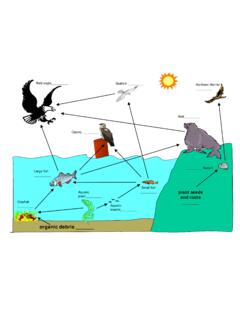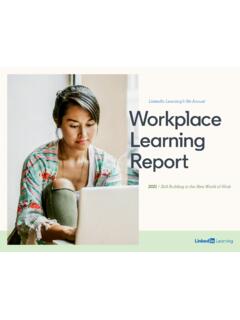Transcription of Food losses and waste in the context of sustainable food ...
1 food losses and waste in the contextof sustainable food systemsA report byThe High Level Panel of Expertson food Security and NutritionJune 20148 HLPE REPORT2 HLPE Reports series #1 Price volatility and food security (2011) #2 Land tenure and international investments in agriculture (2011) #3 food security and climate change (2012) #4 Social protection for food security (2012) #5 Biofuels and food security (2013) #6 Investing in smallholder agriculture for food security (2013) #7 sustainable fisheries and aquaculture for food security and nutrition (2014) #8 food losses and waste in the context of sustainable food systems (2014) All HLPE reports are available at 3 HLPE Steering Committee members (June 2014) Per Pinstrup-Andersen (Chair) Maryam Rahmanian (Vice-Chair) Amadou Allahoury Marion Guillou Sheryl Hendriks Joanna Hewitt Masa Iwanaga Carol Kalafatic Bernardo Kliksberg Renato Maluf Sophia Murphy Ruth Oniang o Michel Pimbert Magdalena Sep lveda Huajun Tang HLPE Project Team members Vishweshwaraiah Prakash (Team Leader) Jane Ambuko Walter Belik Jikun Huang Antonius Timmermans Coordinator of the HLPE Vincent Gitz This report by the High Level Panel of Experts on food Security and Nutrition (HLPE) has been approved by the HLPE Steering Committee.
2 The views expressed do not necessarily reflect the official views of the Committee on World food Security, of its members, participants, or of the Secretariat. This report is made publicly available and its reproduction and dissemination is encouraged. Non-commercial uses will be authorized free of charge, upon request. Reproduction for resale or other commercial purposes, including educational purposes, may incur fees. Applications for permission to reproduce or disseminate this report should be addressed by e-mail to with copy to Referencing this report: HLPE, 2014. food losses and waste in the context of sustainable food systems. A report by the High Level Panel of Experts on food Security and Nutrition of the Committee on World food Security, Rome 2014.
3 4 5 Contents FOREWORD ..9 SUMMARY AND RECOMMENDATIONS .. 11 Main findings .. 11 Recommendations .. 16 INTRODUCTION .. 19 1 food losses AND waste AND sustainable food SYSTEMS: DEFINITION, EXTENT AND IMPACTS .. 21 What are FLW along food chains and how to measure them? .. 21 FLW concepts and definitions .. 21 FLW and FQLW metrics .. 24 Current evaluations of the extent of food losses and waste .. 25 Towards harmonized methodologies and protocols to describe and measure FLW .. 28 What are sustainable food systems? .. 29 FLW, sustainable food systems and food security .. 31 FLW and SFS .. 31 FLW and food security .. 35 2 CAUSES AND DRIVERS OF food losses AND waste .. 39 Stage-specific causes of FLW along the food chain.
4 39 Pre-harvest factors and produce left unharvested .. 41 Harvesting and initial handling .. 42 Storage .. 43 Transport and logistics .. 44 Processing and packaging .. 45 Retail .. 46 Consumption .. 47 Meso-causes of food losses and waste .. 49 Lack of support to actors for investments and good practices .. 50 Lack of private and public infrastructure for well-functioning food chains .. 50 Lack of integrated food chain approaches and management .. 51 Confusion around food date labelling .. 52 Macro-level causes of FLW .. 54 Impact of policies, laws and regulations on FLW .. 54 Systemic 55 3 OPTIONS TO REDUCE food losses AND waste .. 57 Single actor, technical or behaviour-driven solutions to reduce food losses and waste .
5 58 Good practices in crop and animal production .. 58 Storage and conservation solutions .. 58 Technical solutions in transport, processing and packaging .. 60 Solutions for the hospitality 62 Solutions for households .. 63 Concerted and collective solutions to reduce FLW .. 64 Adopt a food chain approach to FLW reduction actions .. 64 Invest in infrastructure .. 65 6 Invest in adapted cold chain developments .. 66 Develop food processing .. 67 Ensure proper capacity building, education, training and extension services .. 68 Unleash the crucial role of women to reduce FLW .. 70 Give a role to corporate social responsibility .. 71 Promote consumer behaviour change .. 71 Give value to surplus saved food .
6 72 Valorize by-products, side streams and non-used food .. 74 Promoting and enabling individual and collective 76 Consider costs and benefits to overcome winners and losers constraints .. 77 Integrate FLW concerns in policies .. 79 Mobilize all actors and consumers for awareness and action .. 83 4 ENABLING THE CHANGE: A WAY FORWARD TO food losses AND waste REDUCTION STRATEGIES .. 89 A way forward to reduce FLW in different contexts .. 89 How to construct the way forward? .. 91 Improve data collection and knowledge sharing on FLW .. 91 Diagnose and develop effective strategies to reduce FLW .. 92 Take effective steps to reduce FLW .. 93 Improve coordination of policies and strategies in order to reduce FLW.
7 95 REFERENCES .. 97 ACKNOWLEDGEMENTS .. 105 APPENDICES .. 107 A1 Causes of FLW by stages in the food chain .. 107 A2 Solutions at different stages of the food chain .. 109 I) Solutions that can be implemented by individual actors (micro level) .. 109 II) Concerted and collective actions to reduce FLW (meso level) .. 110 III) Enabling the change: solutions at macro or systemic level, towards FLW policies and towards consideration of FLW in other policies .. 112 A3 The HLPE project cycle .. 115 List of Figures Figure 1 Schematic representation of the definition of FLW along the food chain .. 23 Figure 2 FLW per capita in the different world regions .. 27 Figure 3 Distribution of FLW along the food chain in the different world 27 Figure 4 Schematic representation of the conceptual links between SFS.
8 FSN anf FLW .. 32 Figure 5 losses along the food chain and organization of causes of FLW .. 40 Figure 6 Schematic representation of agricultural production and destinations .. 75 Figure 7 A food -use-not- waste hierarchy to minimize FLW .. 80 Figure 8 The way forward to food losses and waste reduction strategies .. 90 Figure 9 HLPE project cycle .. 116 7 List of Definitions Definition 1 food loss and waste .. 22 Definition 2 food system .. 29 Definition 3 sustainable food system .. 31 List of Tables Table 1 Examples of potential impacts of FLW on the sustainability of food systems .. 33 Table 2 Categories of solutions to reduce FLW by levels (micro, meso, macro).. 57 List of Boxes Box 1 The methodology of the FAO (2011a) study.
9 28 Box 2 Calorie losses along the food chain, including food losses and waste .. 35 Box 3 Valorization of tuna by-products: an example linking FLW reduction and FSN .. 36 Box 4 Meso-causes along the tomato supply chain in Cameroon .. 50 Box 5 A multitude of different date labels .. 53 Box 6 Use of metal silos to reduce post-harvest losses in grains .. 59 Box 7 Improving fruits conservation in India .. 60 Box 8 Promoting a two-stage grain drying technology in Southeast 61 Box 9 Improving drying technology for omena fish on lake Victoria .. 61 Box 10 Plastic food Containers Bank in Brazil .. 62 Box 11 An experience of tray-less catering in the United States of America .. 63 Box 12 food chain approaches to minimize losses in the dairy sector in Kenya.
10 65 Box 13 Warrant experiment in China: a financial innovation to reduce post-harvest loss .. 66 Box 14 Cold chain intervention in India .. 67 Box 15 Modified atmosphere packaging in the fresh meat supply chain .. 68 Box 16 Capacity building initiatives for food loss prevention in Latin America .. 69 Box 17 Training of trainers in post-harvest handling of perishables .. 69 Box 18 Sharing knowledge and competencies on post-harvest losses .. 69 Box 19 In Kenya Ukambani women reaping profits by processing fruits .. 70 Box 20 Transparency and actions of retailers on food losses and waste reduction .. 71 Box 21 Cozinha Brasil (Kitchen Brazil).. 72 Box 22 Examples of side stream valorization .. 75 Box 23 Transforming waste in nutritious food and feed: the potential of worms and insects.












